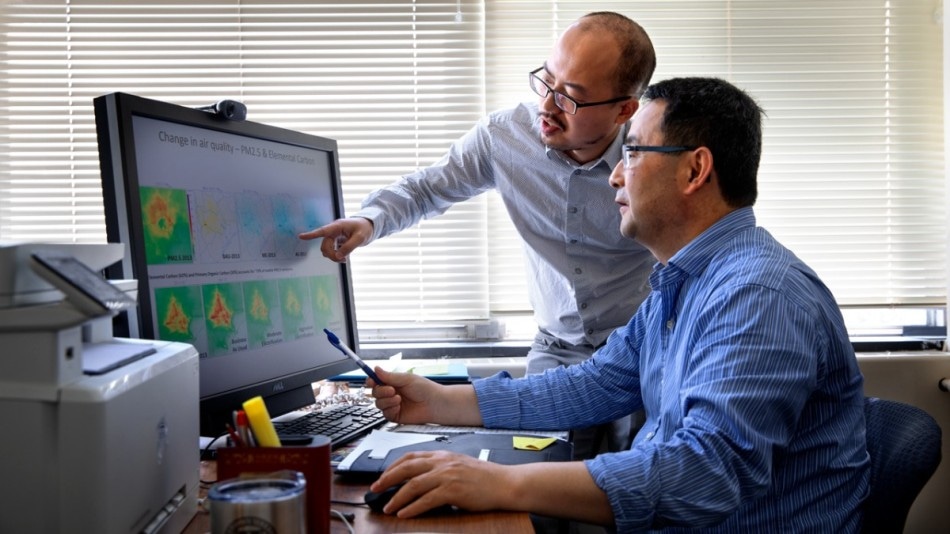Jun 12 2019
According to the April 2019 report “State of the Air” released by the American Lung Association, Houston is ranked 17th for particle pollution and 9th nationally for worst ozone pollution.
 Oliver Gao, front, and Shuai Pan pore over research that shows that by replacing at least 35% of Houston’s gasoline cars and diesel trucks with electric vehicles by 2040, Houstonians could breathe easier. (Image credit: Jason Koski/Cornell University)
Oliver Gao, front, and Shuai Pan pore over research that shows that by replacing at least 35% of Houston’s gasoline cars and diesel trucks with electric vehicles by 2040, Houstonians could breathe easier. (Image credit: Jason Koski/Cornell University)
However, researchers at Cornell University are expressing hope for the future of Houston’s breathable air: If at least 35% of Houston’s diesel trucks and gasoline cars are replaced with electric vehicles, Houstonians can live longer, breathe easier, and enjoy a better economy.
The built environment plays a significant role in affecting our daily life and health.
H. Oliver Gao, Study Senior Author and Professor, Civil and Environmental Engineering, Cornell University
The study titled, “Potential Impacts of Electric Vehicles on Air Quality and Health Endpoints in the Greater Houston Area in 2040” has been reported in Atmospheric Environment.
According to Gao, who directs Cornell University’s Center for Transportation, Environment and Community Health and a fellow at the university’s Atkinson Center for a Sustainable Future, over two-third of the oil imported by the United States is utilized for transportation.
While transportation provides us with mobility, it impacts our environment and our public health. We are enjoying this mobility at a very high cost.
H. Oliver Gao, Study Senior Author and Professor, Civil and Environmental Engineering, Cornell University
Gao and Shuai Pan, a postdoctoral associate in civil and environmental engineering, together with a group of engineers and chemists, modeled four kinds of scenarios using different levels of electric car adoption to observe how air quality and public health in Houston would respond 20 years from now.
The investigators analyzed Houston’s daily 8-hour average concentrations of ground-level ozone. The four scenarios modeled by the researchers were:
- aggressive electrification (70% electric)
- moderate electrification (35% electric)
- maintaining business-as-usual
- complete turnover (35% electric, plus 65% possibly newer emission and combustion control technologies)
The business-as-usual model for surface ozone in 2040 demonstrated increased parts-per-billion concentrations. In the aggressive electrification scenario and the moderate electrification scenario, the models demonstrated considerable enhancement by decreasing surface ozone parts-per-billion. With almost complete turnover (reduced emissions of about 95%), that model revealed a reduction of three to four parts per billion of surface ozone over most of Houston.
At present, ozone “design value”—a regulatory statistic”—is approximately 80 parts per billion in Houston; 70 parts per billion is the current standard.
A decrease of 3 to 4 parts per billion of average ozone – from on-road mobile sources, for example—would be considered a large improvement.
Shuai Pan, Postdoctoral Associate, Civil and Environmental Engineering, Cornell University
The authors observed that by 2040, the population of Houston is estimated to rise by 50%, which is likely to increase the activity of motor vehicles and the number of trucks by two-fold. As a matter of fact, the number of commercial trucks will increase by 40% to 80% and the number of gasoline vehicles will increase by 30% to 50%, according to the Texas Transportation Institute.
There are atmospheric implications on this. Cities and regions are in need of policies that will help push electrification, so that we can … gain health benefits and improve air quality.
H. Oliver Gao, Study Senior Author and Professor, Civil and Environmental Engineering, Cornell University
According to Pan, even if Houston’s vehicle population nearly increased by two-fold by 2040, the state would have a relatively smaller emission factor than the present-day one, and this can be attributed to zero-emission technology at the systems level.
“The population in 2040 Houston will see a huge increase, but we can apply new technology to reduce emissions, improve air quality and think about health,” stated Pan, who received his PhD in atmospheric science from the University of Houston in the year 2017.
The investigators also noted that power resources should not be burdened, although the power grid will be added with charging stations for electric vehicles. They also stated that there is not a major requirement to construct more power plants.
The exhaust of diesel and gasoline vehicles contains nitrogen oxides, which are volatile organic compounds that form ozone by reacting in the presence of sunlight and increase harmful fine particulates—elements that are known to have a negative impact on human health.
If present levels of ozone and particulate matter are not controlled, they would lead to 122 more premature deaths every year across the greater Houston by 2040.
With aggressive or moderate electrification for trucks and cars, the numbers indicate an improvement in air quality, with prevented premature deaths at 188 and 114, respectively.
With regards to the complete turnover scenario to electric vehicles, the number of prevented premature deaths around Houston increases to 246 annually.
Mayors or policymakers—who care about the environment, the economy and public health—must advocate for electrification. The knowledge is there, but we need mayors and city planners to be creative and innovative to design policies that would help the electrification of the transportation sector.
H. Oliver Gao, Study Senior Author and Professor, Civil and Environmental Engineering, Cornell University
Other researchers who contributed to the study were postdoctoral fellow Anirban Roy, associate professor of atmospheric chemistry Yunsoo Choi, and doctoral candidate Ebrahim Eslami, all from the University of Houston; Xiangyu Jiang from the University at Buffalo; and Stephanie Thomas, Public Citizen, a nonprofit public advocacy organization.
The U.S. Department of Transportation funded the study.